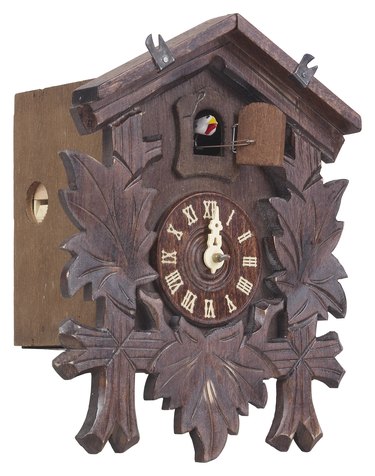
Cuckoo clocks date from the early part of the 18th century, originating in German's Black Forest region. Their genesis is most often attributed to Franz Anton Ketterer, who developed the unique system for producing the cuckoo's sound. While materials and additional features may have evolved over the centuries, the basic components inside the cuckoo clock have remained the same
The Movement
Video of the Day
The movement is the part of the cuckoo clock that tells time and so controls all the other elements. There are no electrical components to a cuckoo clock; instead, weights – either two or three and traditionally shaped like pinecones -- hanging down below the clock determine the movement. These steadily drop over either a one-day or eight-day period. As they drop, they move a series of cogs within the clock to which trigger levers are attached that operate the cuckoo, its call and the gong.
Video of the Day
The Cuckoo
The bird and the door through which it appears are attached to the movement by wires that activate them at the designated times. The cuckoo mounts on a hinged bracket that allows the bird to move through the open door at the requisite moment. Some cuckoos extrude fully from the clock, while others only come half out, with the top of the bellows responsible for the call animating the bird from behind.
The Call
The distinctive cuckoo call comes from two tiny sets of bellows attached to whistles inside the clock. The bellows are activated by the movement, which first raises the top hinged bellows to fill them with air then squeezes them to force air out over the top of the whistle. This activates the whistles in turn, one producing the "cu" sound, the second responsible for the following "ckoo" noise.
The Gong
Besides the bird's call, most cuckoo clocks also feature a gong that announces the hour or half-hour and either precedes or follows the appearance of the bird. The gong fits to the back of the clock, while the hammer that strikes it attaches by a wire to the movement. The hammer lifts at the appropriate time and then falls against the gong.